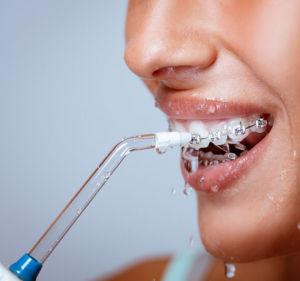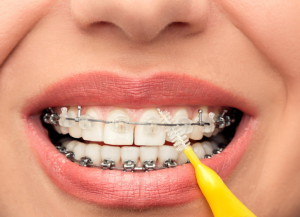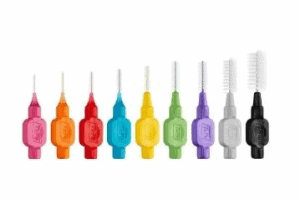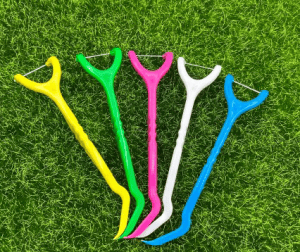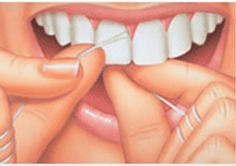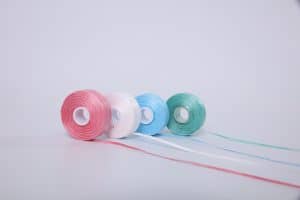Maintaining good oral hygiene is essential for a healthy smile and overall health. Brushing twice a day is an excellent start, but flossing is equally important. Flossing removes plaque and food particles from between the teeth and under the gum line, preventing tooth decay, gum disease, and bad breath.
While traditional string floss is effective, some people find it challenging to use. Fortunately, there are many different types of flossing tools available that can make the process easier and more effective. Here are some of the best flossing tools on the market:

1. Water Flosser
A water flosser, also known as an oral irrigator, is a device that uses a stream of pressurized water to clean between teeth and along the gum line. It is a modern alternative to traditional flossing, which can be challenging for some people to use.
A water flosser typically consists of a handheld device with a water tank and a nozzle. To use a water flosser, you fill the tank with water, attach the nozzle, and then direct the stream of water between your teeth and along your gum line. This helps to remove plaque, bacteria, and food particles that may have been missed during brushing.
Water flossers can be particularly beneficial for those with braces or dental implants, as they can effectively remove debris and bacteria from hard-to-reach areas. They are also a gentler option for those with sensitive gums or who may experience bleeding with traditional flossing.
Studies have shown that water flossing can be as effective, if not more effective, than traditional flossing in reducing plaque and preventing gum disease. Additionally, many water flossers come with different pressure settings, making it easy to adjust the pressure to your comfort level.
2. Interdental Brush
An interdental brush is a small, narrow brush designed to clean the spaces between teeth and under orthodontic appliances such as braces or bridges. It is a useful tool for removing food particles and plaque that can cause tooth decay, gum disease, and bad breath.
Interdental brushes typically have a small, cone-shaped or cylindrical head that is attached to a long, thin handle. The brush head is made up of multiple bristles that are designed to fit between teeth and reach into tight spaces.
To use an interdental brush, you should choose a brush that fits snugly between your teeth without causing discomfort. Then, gently insert the brush into the space between your teeth, moving it back and forth in a gentle motion. Be sure to clean both sides of each tooth and move on to the next space.
Interdental brushes are particularly effective in removing plaque and bacteria from tight spaces, and are especially useful for those with braces or dental implants. They are also a good option for those who find traditional flossing difficult or uncomfortable.
It is important to use an interdental brush correctly to avoid causing damage to your teeth or gums. Be sure to choose the right size brush, use gentle motions, and replace the brush regularly to avoid spreading bacteria.
3.Floss Pick
A floss pick typically consists of a small plastic handle with a curved end that holds a short piece of floss. The handle is designed to make it easy to maneuver the floss between teeth and along the gum line.
To use a floss pick, you should hold the handle and insert the floss between your teeth, moving it back and forth in a gentle motion. Be sure to clean both sides of each tooth and move on to the next space. You can use a new floss pick for each tooth to prevent spreading bacteria.
Floss picks can be particularly beneficial for those on the go, as they are portable and easy to use. They are also a good option for those with braces or dental appliances, as they can effectively clean between wires and brackets.
However, it is important to note that floss picks may not be as effective as traditional flossing or other flossing tools such as interdental brushes or water flossers. They may not be able to reach tight spaces as effectively, and the short piece of floss may not be sufficient for those with larger gaps between teeth.
4. Air Flosser
An air flosser is a type of flossing tool that uses bursts of air and water to remove plaque and food particles from between the teeth and gum line. Unlike traditional string floss, which can be difficult to use and may cause discomfort or bleeding, an air flosser is a gentler and more comfortable option. It can be a valuable addition to your oral hygiene routine. It can help to reduce the risk of cavities, gum disease, and bad breath, while also promoting healthy gums and a beautiful smile.
An air flosser typically uses a small, handheld device that is easy to operate. It works by filling a reservoir with water and then directing a stream of air and water between the teeth and gums. This helps to flush out debris and bacteria from places that are difficult to reach with a toothbrush or traditional floss.
Air flossers can be particularly beneficial for those with sensitive gums or braces, as they are less likely to cause irritation or damage. They are also a convenient option for those on the go, as they are portable and easy to use.
5. Traditional Dental Floss
Traditional flossing is the practice of using a thin strand of floss to clean between teeth and under the gum line. This is done to remove plaque and food particles that brushing alone cannot reach, and to prevent tooth decay, gum disease, and bad breath.
To use traditional floss, you should start by breaking off a piece of floss that is approximately 18 inches long. Then, wrap each end of the floss around your fingers, leaving about 1-2 inches of floss to work with.
Next, gently slide the floss between your teeth, using a back-and-forth motion. Be sure to curve the floss around the base of each tooth, making sure to get under the gum line. You should use a new section of floss for each tooth to prevent spreading bacteria.
When done correctly, traditional flossing can be very effective in removing plaque and preventing gum disease if you choose the right type of floss.
Traditional floss comes in several different types, each with its own unique features and benefits. Here are some of the most common types of traditional floss:
- Nylon floss: Nylon floss is a traditional floss made of nylon fibers that are twisted together. It is available in waxed and unwaxed varieties, and can come in different flavors. Nylon floss is a versatile option that can work well for most people.
- Dental tape: Dental tape is a wider, flatter floss that is made of nylon or PTFE (polytetrafluoroethylene). It is designed to slide more easily between teeth and is often preferred by those with wider gaps between their teeth.
- Super floss: Super floss is a type of floss that is thicker and more textured than traditional floss. It is made up of three components: a stiffened end to thread between teeth, spongy floss to clean around appliances, and regular floss for everyday cleaning.
- Silk floss: Silk floss is a natural floss made from silk fibers. It is a softer and more delicate option than nylon floss, making it a good choice for those with sensitive gums.
- Expanding floss: Expanding floss is a type of floss that expands when it comes into contact with water or saliva. This can help to clean more effectively between teeth and remove plaque and debris.
Each type of traditional floss has its own advantages and disadvantages, and it may take some trial and error to find the right type for your needs. It is important to choose a floss that you are comfortable using and that effectively removes plaque and bacteria to promote good oral health.
In conclusion, flossing is an essential part of maintaining good oral hygiene. While traditional floss is effective, there are many different flossing tools available that can make the process easier and more effective. From water flossers to interdental brushes, there’s a tool to suit everyone’s needs. Experiment with different flossing tools to find the one that works best for you, and don’t forget to floss regularly for a healthy smile.


